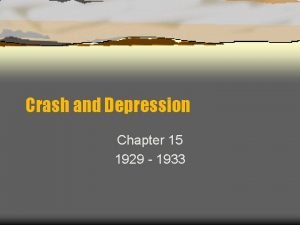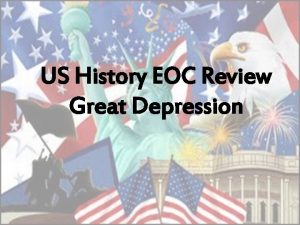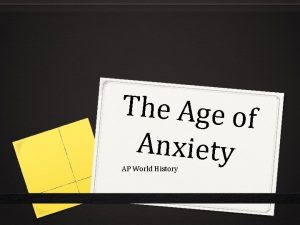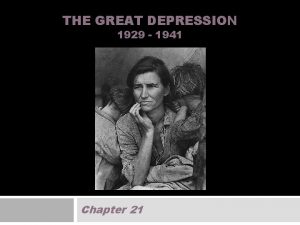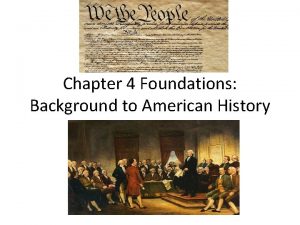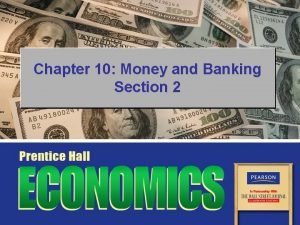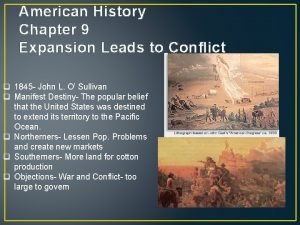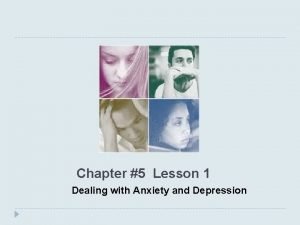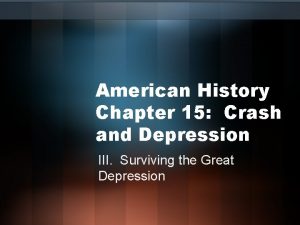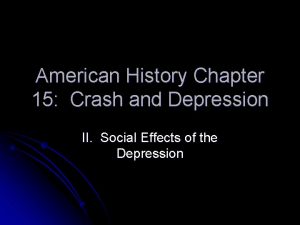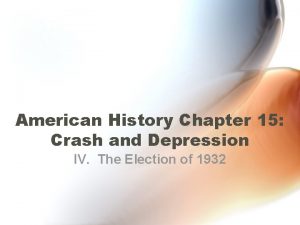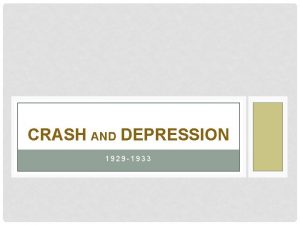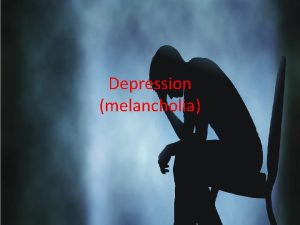American History Chapter 15 Crash and Depression I








- Slides: 8

American History Chapter 15: Crash and Depression I. The Stock Market Crash

Objectives • Learn about events that led to the stock market’s Great Crash in 1929. • See how the Great Crash produced a ripple effect throughout the nation’s economy. • Become familiar with the main causes of the Great Depression.

Bell Ringer • What would happen if you went to your bank and asked to withdraw money from your savings account and were told that there is no money. • What might cause that situation? • What options would you have? • What do you know about the Great Depression. (page 508)

A) The Market Crashes 1) • • • 2) 3) 4) Dow Jones Industrial Average: an average of stock prices of major industries September 3 rd all time high – 381 /8018 Stock prices were higher than what they were worth Black Thursday – Oct 24 – dropped 21 points in last hour GE 400 – 283 Black Tuesday: Oct 29 th – record number of stocks sold the great crash Great Crash: collapse of the stock market 381 -198 – 30 billion in losses Business cycle: the periodic growth and contraction of a nation’s economy

B) The Ripple Effect of the Crash • At first only investors hurt – did trickle down • Risky loans hurt banks – with the crash the business lost could not repay • Consumer borrowing – people borrowed to buy things – loans recalled • Bank runs – people rushed to get money out of banks – called in loans – business that were hurt couldn’t pay • Bank failures – banks that couldn’t pay went broke • Savings wiped out – when banks went so did savings • Cuts in production – can’t borrow to expand, nobody had money to buy anyway • Rise in unemployment • Further cuts in production – unemployment grew and incomes shrank – consumers spent less and business produced less

• Economic Contraction – decline marked by falling output of goods and services – long one is called a depression 5) Great Depression: most severe economic downtown in the nation’s history • Factories closed – small business next – farm prices fell – 1932 – 25% of work force unemployed – GNP dropped in half • World nations interdependent – US quit investing in Germany – Germany suspended reparation payments – Alias quit repaying war loans to US

C) Underlying Causes of the Depression • An unstable economy – most money in the hands of few rich – not consumers/ industry produced more than could be bought/ Farmers and workers not getting money • Over speculation – people bought stocks and used those stocks as collateral to buy more – money is all borrowed, not there • Government polices – the FED did not lower interest rates after crash to increase money supply

Review • What events led to the stock market’s Great Crash in 1929. • Why did the Great Crash produce a ripple effect throughout the nation’s economy? • What were the main causes of the Great Depression?
 October 29 1929
October 29 1929 Stock market crash cartoon
Stock market crash cartoon Main idea
Main idea Great depression ap world history definition
Great depression ap world history definition Http://www.history.com/topics/great-depression
Http://www.history.com/topics/great-depression Chapter 4 foundations background to american history
Chapter 4 foundations background to american history Chapter 10 section 2 the history of american banking
Chapter 10 section 2 the history of american banking American history chapter 9
American history chapter 9 Chapter 5 lesson 1 dealing with anxiety and depression
Chapter 5 lesson 1 dealing with anxiety and depression
